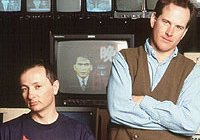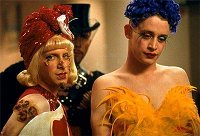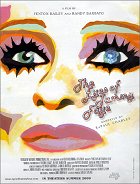and the return to the big screen of that Home Alone brat • page 1 of 2

 “For you the party is over!” New York Supreme Court Justice William Wetzel uttered these words as he sentenced the club promoter Michael Alig to prison in 1997 for the murder of his friend and drug dealer Angel Melendez. Alig won’t be eligible for parole until 2006, but he has found new fame behind bars in the film Party Monster, about his glamorous and outrageous life as the pied piper of New York’s Club Kids in the late ’80s and early ’90s. And he’s played by Macaulay Culkin, who starred in Home Alone and Richie Rich, who hadn’t made a film in six years.
“For you the party is over!” New York Supreme Court Justice William Wetzel uttered these words as he sentenced the club promoter Michael Alig to prison in 1997 for the murder of his friend and drug dealer Angel Melendez. Alig won’t be eligible for parole until 2006, but he has found new fame behind bars in the film Party Monster, about his glamorous and outrageous life as the pied piper of New York’s Club Kids in the late ’80s and early ’90s. And he’s played by Macaulay Culkin, who starred in Home Alone and Richie Rich, who hadn’t made a film in six years.The Club Kids were famous for being shocking. It was all about becoming a celebrity through sheer willpower ... and there was also something of the performance artist as each Club Kid poked fun at the idea of stardom, rampaging through Manhattan’s streets and nightclubs as if they owned the place, defying the police and any other authority. And using all the drugs they could get their hands on.
Filmmakers Fenton Bailey and Randy Barbato were no strangers to the scene. They helped launch the career of drag diva RuPaul during this period, and were fascinated by the Club Kids movement. But they couldn’t find anyone to finance a documentary about the scene until Alig “accidentally” confessed to the murder on a TV programme one night. Suddenly it was big news, and Bailey and Barbato quickly got their hands on the Club Kids home video tapes.
“The Club Kids kind of documented themselves,” Bailey says. “They were the first generation to have these little video cameras and they were always living in the eye of each others’ lenses.” Their documentary, also titled Party Monster, was released in 1998 featuring interview footage of Alig in prison and on-screen narration from Alig’s best friend and nemesis James St James, who was at the time just starting work on a book about the murder, Disco Bloodbath.
St James and Alig have both claimed credit for the Club Kids movement, and their struggle for power is the centre of the new film, which plays out like a deranged love story between these two men. The combination of vitriol and affection between them is the best thing about the film, as St James teaches Alig how to work a room and become a celebrity ... and as Alig serves St James a glass of urine but tells him it’s champagne.
Culkin acquits himself nicely as a fey version of the much more charismatic Alig; it’s an uneven, oddly flouncing performance that still works somehow. But the very camp St James is played with astonishing clarity and humour by Seth Green (better known as Scott Evil in the Austin Powers movies). Talk is already afoot of a possible Oscar nomination.
“There was a wealth of material available,” Green says of the documentaries, TV clips and home videos he watched. “Plus getting to meet them and spend time with them. Mac and I made a pact to do it as hard as I can, and you come with me. No one who was involved in the Club Kids scene had any shame or fear connected with what they were doing. And to play these people accurately you can’t have any of that.”
St James interjects: “Well, Seth has great legs, a nice ass and looks good in a wig. That’s all it takes to play me! And he really is wearing my clothes in almost every scene. Although he’s shorter than me so now I have, like, Hobbit clothes!” St James’ memorable personas include such fusion characters as a geisha gangster, Martian hooker and purple grizzly bear. He’s called this film his “Erin Brockovich moment.”
Meanwhile, Culkin travelled to prison to spend five hours with Alig. “I figured everything in his life was leading up to somebody making a movie about it, and now he had the chance to talk to the actor playing him,” Culkin says. “He talked about the murder and was very forthcoming with information. Whether it was true or not is beside the point; he was invaluable.”
Being in a room with these five people is like attending a truly warped family reunion. Bailey and Barbato are the been-there-done-that parents, survivors of the party scene who have turned their obsession with all things camp into a career (their filmography includes the divine doc The Eyes Of Tammy Faye). Culkin and Green are like over-educated children, articulate and analytical but with an evil glint in their eye. And St James is the flamboyant mad auntie dropping hilarious comments into the mix.







